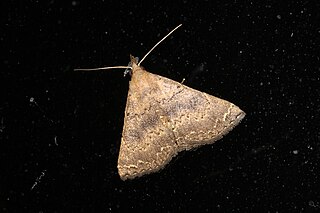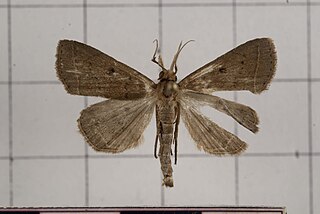Ambia is a genus of moths of the family Crambidae.

Hypena iconicalis is a moth in the family Noctuidae first described by Francis Walker in 1859. It is found in India, Sri Lanka, Taiwan, Papua New Guinea and Fiji.

Gesonia obeditalis is a species of moth of the family Noctuidae first described by Francis Walker in 1859. It is found from eastern Africa, the Seychelles, the Maldives and the Oriental tropics of India, Sri Lanka east to the Philippines, the Sula Islands and Australia. The adult moth has brown wings with a scalloped dark brown band near the margin. The hindwings are similar in pattern to the forewings but are a paler shade of brown.
Glaucoclystis polyclealis is a moth in the family Geometridae described by Francis Walker in 1859. It is found in Sri Lanka and on Borneo, Java and Bali.
Ambia tenebrosalis is a moth in the family Crambidae. It is found in Sri Lanka.
Ambia xantholeuca is a moth in the family Crambidae first described by George Hampson in 1896. It is found in Sri Lanka.
Brana is a monotypic moth genus of the family Noctuidae. Its only species, Brana calopasa, is found in Sri Lanka and Australia. Both the genus and species were described by Francis Walker, the genus in 1858 and the species in 1859. It It is a serious pest on Berrya cordifolia.
Chusaris retatalis is a moth of the family Noctuidae first described by Francis Walker in 1859. It is found in Sri Lanka.
Noreia ajaia is a moth of the family Geometridae first described by Francis Walker in 1859. Its geographical range includes areas from the Oriental regions of India and Sri Lanka to Singapore and Sundaland.
Hadennia jutalis is a moth of the family Noctuidae first described by Francis Walker in 1859. It is found in India, Sri Lanka, Thailand, Malaysia, Laos, Vietnam, Myanmar and the Andaman Islands.
Hadennia mysalis is a moth of the family Noctuidae first described by Francis Walker in 1859. It is found in Sri Lanka, Japan, Taiwan, Thailand, Borneo, Myanmar and the Andaman Islands.

Hydrillodes abavalis is a moth of the family Erebidae first described by Francis Walker in 1859. It is found in Sri Lanka and Borneo.

Hydrillodes gravatalis is a moth of the family Erebidae first described by Francis Walker in 1859. It is found in the Indian subregion, Sri Lanka and Sundaland.

Progonia oileusalis is a moth of the family Noctuidae first described by Francis Walker in 1859. It is found in Sri Lanka, Borneo, India, Taiwan, Japan and the Philippines.

Simplicia butesalis is a moth of the family Erebidae first described by Francis Walker in 1859. It is found in Borneo, Sumatra, Peninsular Malaysia and Sri Lanka.
Corgatha zonalis is a moth of the family Erebidae first described by Francis Walker in 1859. It is found in Oriental tropics of India and from Sri Lanka to Borneo, the Philippines and Japan.
Hypena mandatalis, is a moth of the family Erebidae first described by Francis Walker in 1859. It is found in the Indian subregion, Pakistan, Sri Lanka, Borneo, Sulawesi and Australia.
Mathoris loceusalis is a moth of the family Thyrididae first described by Francis Walker in 1859. It is found in India, Sri Lanka and Australia.
Hypolamprus bastialis is a moth of the family Thyrididae first described by Francis Walker in 1859. It is found in India, Sri Lanka, Indonesia, New Guinea and Australia.
Labanda herbealis is a moth in the family Nolidae first described by Francis Walker in 1859. It is found in Sri Lanka and Borneo.




